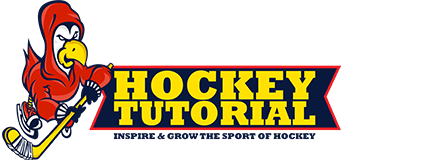First part of the written tutorials is understand what takes place during the snap shot,
The hockey stick is aggressively slapped and bent on the ice, the build up of tension from the stick hitting the ice is then released against the puck in the direction intended. This type of shot can be incredibly fast (generating speeds over 100MPH), but is not as accurate or as convenient as some of the other shots.
When should you use the snap shot?
The Snap shot is a fun shot to make, but most of the time (depending on the playing) it can be a very ineffective shot to use. The snap shots should be used primarily by a defenseman when in his position near the blue line (close to the net).
Taking a Snap shot
 Point your feet towards the puck, which should be about 2-3 feet from your skates.
Point your feet towards the puck, which should be about 2-3 feet from your skates.
Do not point your skates at your target (target being the net) this is a huge mistake made by beginners, once you build more skill in taking Snap shots, this will be possible later on,
.
 The key to the speed of the snap shot is in the flex of the stick followed by the weight of the shooter. The stick should impact the ice a few inches from the puck, this allows the weight of the player to flex the stick, and then un-flex driving the puck at high speed.
The key to the speed of the snap shot is in the flex of the stick followed by the weight of the shooter. The stick should impact the ice a few inches from the puck, this allows the weight of the player to flex the stick, and then un-flex driving the puck at high speed.
A lot of players mistakenly hit only the puck, thinking the ice will slow their shot, this is not the case if the snap shot is carried out correctly
As you follow through you need to turn your hits towards the direction of the target for weight and power transfer.
During contact with the puck, roll your wrists so that the thumb on your dominant hand turns down towards the ice adding more accuracy to the shot.
Follow through with your shot to where you’re aiming.
Remember after hitting the puck to follow through completely in the direction you want the puck to go. This makes for a more accurate shot, and it also helps keep your puck stable while flying through the air.
 Your shoulders should finish facing the net, your hips should twist towards the direction of the shot, and your front foot should turn towards the direction of the shot. After following through, your stick and body should be pointing towards the direction of your shot.
Your shoulders should finish facing the net, your hips should twist towards the direction of the shot, and your front foot should turn towards the direction of the shot. After following through, your stick and body should be pointing towards the direction of your shot.
If you follow through with your stick aiming high, the puck will go high, if you keep the stick low, the puck will stay low.
.
Aiming
You probably won’t have much time to get your puck off if you spend too much time aiming at this point. A simple glance will do for now to get the general direction of where you want to shoot.
Grip and how to hold the stick
If you’re right-handed, you should be holding your stick with your left hand at the top. Your right hand should be lower than where you would normally carry it when stick-handling or skating. Make sure your hands are shoulder length apart on the stick, as the stick reaches its highest point your hands will separate a little more and move down the shaft, and as you finish the shot, your hand should end up somewhere near shoulder length apart. Majority of left handed hockey players shoot on the left making these instructions completely backwards. Your right hand would be on the top of the stick because you would use your dominant hand for best control.
Don’t lift to high.
Do not do this to an extreme as pulling back way above your head will not add more power into your shot, instead it will sacrifices time and accuracy. Pulling the stick back slightly above your waist should be fine. At this point you should be looking down at the puck so you do not miss it.
For beginner trying to learn the overall movement, during the windup don’t bring the blade of your stick any higher than your waist. Once you have a reasonable shot, you can increase your windup. With a good technique it’s possible to shoot a great snap shot without winding up to much.
Remember to take another look at the goal as you wind up for your shot, if you’re going for a goal you need to be sure to aim for a particular spot, and not just the goal alone. You can also use this shot in the hope a teammate will catch the rebound (this is recommended over an actual shot for a goal), keep your eyes on the ice and on your teammates stick side to increase the chance of them grabbing the puck in time.



